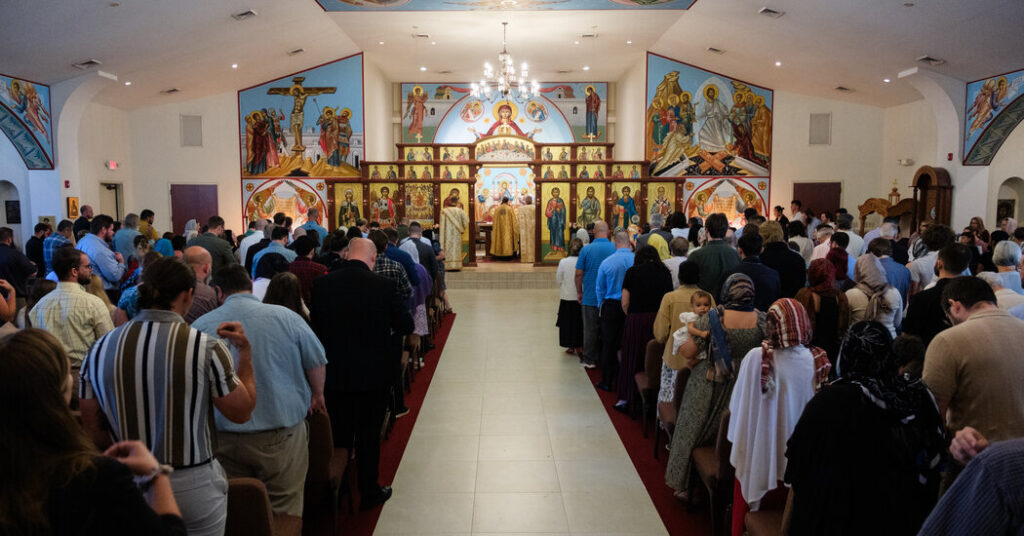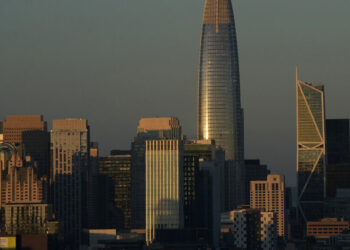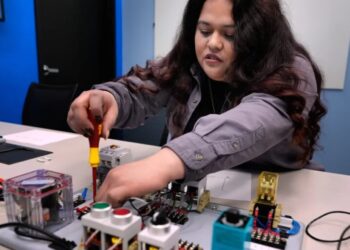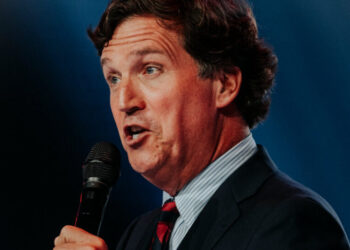Something is changing in an otherwise quiet corner of Christianity in the United States, one that prides itself on how little it has changed over time. Priests are swapping stories about record attendance numbers. Older members are adjusting — or not — to the influx of new attendees. Parishes are strategizing about how to accommodate more prospective converts than existing clergy can reasonably handle on their own.
Across the country, the ancient tradition of Orthodox Christianity is attracting energetic new adherents, especially among conservative young men. They are drawn to what they describe as a more demanding, even difficult, practice of Christianity. Echoing some of the rhetoric of the so-called manosphere, new waves of young converts say Orthodoxy offers them hard truths and affirms their masculinity.
“In the whole history of the Orthodox Church in America, this has never been seen,” the Very Rev. Andrew Damick, an Antiochian Orthodox priest and author in Eastern Pennsylvania, said of the large groups of young people showing up at many parishes. “This is new ground for everyone.”
In the United States, Orthodox Christianity is by far the smallest and least-known of the three major branches of Christianity, representing about 1 percent of the population, compared with about 40 percent who are Protestant and 20 percent who are Catholic. Orthodox pews here have historically been occupied by immigrants from Ukraine, Greece and other countries with large Orthodox populations. Their American-born children often drift to other churches.
But a homegrown Orthodox Christianity is strikingly emergent. Many of the young Americans new to the pews have been introduced to Orthodoxy by hard-edge influencers on YouTube and other social media platforms. Critics call the enthusiastic young converts “Orthobros.”
One night this summer, the young adults of All Saints Orthodox Church in Raleigh, N.C., gathered at a bookshop and bar on the city’s north side. At the event’s peak, there were a mere handful of women present, and more than 40 men. The men noticed, and believed they knew why.
Orthodoxy “appeals to the masculine soul,” said Josh Elkins, a student at North Carolina State University who was chatting with other young men.
“The Orthodox Church is the only church that really coaches men hard, and says, ‘This is what you need to do,’” said Mr. Elkins, 20, who casually quoted a second-century martyr and rattled off terms like “monarchical episcopate” in conversation. He beamed as he talked about the weekly worship service known as the Divine Liturgy, an hourslong affair at which attendees typically stand the entire time, rather than sitting in the pews or kneeling.
The Divine Liturgy is just one aspect of Orthodox faith and practice that is unfamiliar to many Americans, including other Christians. Orthodox services include chanting, incense and genuflecting deeply before painted icons. Much of the liturgy takes place out of the sight of the congregation. The church also maintains a strict and complicated schedule of fasting.
“It’s so much harder than I thought it was going to be,” said Matthew Herman Hudson, 29, who converted in his early 20s and works in the bookstore in Raleigh. “But it speaks to me in a way that nothing else ever did.”
Mr. Hudson said that when he first converted, he had to explain to friends what Orthodoxy was. Now, customers at the bookstore often identify his necklace as an Orthodox cross, with its distinct three bars.
Generation Z is upending the expectations of many scholars and faith leaders, who watched the country steadily secularizing for decades, with each generation less religious than the last. Some recent surveys suggest that young adult men are defying that trend.
The Orthodox Church traces its ecclesiastical lineage to Jesus Christ and the early apostles. As Christianity expanded in its first millennium, a theological and political divide opened between the Eastern church and the Western, or Roman Catholic, church. A schism in the 11th century over issues including papal authority divided the two bodies definitively, with Eastern Orthodoxy flourishing in the Middle East, Eastern Europe and Russia.
Orthodox Christians in the United States are younger and more male than many other Christian groups here. More than 60 percent of them are men, compared with 46 percent of evangelicals, according to the Pew Research Center. Orthodox Christians are also much younger, with 24 percent of adult adherents younger than 30, compared with 14 percent of evangelicals. The gaps are the same as those between Orthodox Christians and Catholics.
Some converts report approvingly that Orthodoxy has a more masculine feel than other traditions. Priests, who must be male and can marry, often have large beards and big families. Orthodoxy asks practitioners to make sacrifices like fasting, rather than offering them emotional contemporary music and therapeutic sermons, which critics describe as the typical evangelical megachurch experience.
“There’s no war for us to die in — well, there are wars for us to die in, just not ones that are honorable,” Laric Copes Jr., 28, who attends All Saints, said. For former Protestants like himself, Orthodoxy serves as “a kind of frontier of exploration,” he said.
“Young men need purpose, whatever that is,” said Jerod Stine, 26. “Young men are struggling to find jobs, they’re struggling to get into schools, and they’re really being told by society, ‘We don’t really need you.’”
Mr. Stine and Mr. Copes used to attend the same evangelical megachurch, but lost track of each other when the church collapsed in scandal. They reconnected for the first time in years at the Orthodox gathering at the bookstore.
The new energy in many Orthodox parishes tracks with broader trends among young men embracing harder-edge and more intense versions of several Christian traditions. In the Catholic church, a significant minority of young people prefer the pre-Vatican II Traditional Latin Mass, and attend parishes where women wear veils to mass.
These remain relatively small religious subcultures, but they are part of a shift that enthusiastic observers are calling a revival. Pew Research found this year that after years of decline, the Christian population in the United States has been stable for several years, a change fueled in part by young adults.
Some argue that the common denominator in churches attracting young people is not their style of worship but their treatment of the supernatural. Father Damick, the priest in Pennsylvania, pointed out that charismatic Christianity, whose theology includes an openness to faith healing and “spiritual warfare,” has also resisted trends of religious decline.
“You’re much more likely to see growth in churches that are not just conservative morally, but that take the unseen world seriously,” said Father Damick, who is also chief content officer of Ancient Faith Ministries, a pan-Orthodox publisher and media group.
Many converts say they appreciate the notion that Orthodox theology and practices have remained the same since the birth of Christianity.
As a joke recounted fondly in Orthodox circles puts it: “How many Orthodox does it take to change a lightbulb?” The answer: “Change? What’s that?”
“The Orthodox Church stands as the hope of those who wish to be normal, to be healthy, true and beautiful,” said the Rev. David Winn, the priest at All Saints.
Father Winn, 38, converted in the early 2010s. He has a seemingly endless energy for meeting with people curious about the church. His wife, Destinie, runs a popular Orthodox parenting account on Instagram when she is not home-schooling their four — soon to be five — children, or hosting groups from the church on their big back porch overlooking a patch of woods in nearby Cary.
Father Winn arrived at All Saints in 2020, the year that many observers say was pivotal for the growth of Orthodox Christianity in the United States. Orthodox churches were significantly more likely than others to ignore the coronavirus pandemic and continue to hold in-person services.
By 2023, in-person attendance at worship services had bounced back completely at the average Orthodox parish, while at other religious congregations it lagged behind, according to research published last year.
Some Orthodox parishes now have their own schools, long a rarity in a tradition with such small numbers. The pan-Orthodox Saint Constantine School has more than 500 students at its flagship school in Houston, which opened in 2015. The network opened a new campus in Pittsburgh last year, and another in Dallas this fall.
In North Carolina, All Saints is exploring the possibility of opening a school, as well as adding a second priest and a new location. This fall, the parish had a record 165 catechumens, people in the typically yearlong process of formally joining the Orthodox Church.
The online influencers that many young men credit with introducing them to Orthodoxy speak directly about politics and culture in a way that parish priests more often avoid. They tend to share an unbending social conservatism, with a particular interest in the “traditional family” and what they describe as the threats of feminism, homosexuality and transgender identities. They are also generally opposed to the state of Israel.
The Rev. Josiah Trenham, one of the most well-known American priests, appeared on Tucker Carlson’s show shortly after the assassination of the right-wing activist Charlie Kirk to discuss Christian mourning traditions. In a more recent video reflection on the prominent white nationalist Nick Fuentes’s appearance on Mr. Carlson’s show, Father Trenham claimed he didn’t know much about Mr. Fuentes and went on to praise the men’s conversation about the scourge of pornography.
Father Trenham’s congregation in Riverside, Calif., has more than 1,000 active parishioners, and 241 in the process of converting. “Five years ago I had 75, which I thought was a lot,” he said in an interview this fall. “The trajectory is increasing.”
Certain corners of the Orthodox internet are not just conservative or traditionalist, but openly racist and antisemitic, with several far-right figures converting in recent years. In the South, there is a strain of neoconfederate Orthodoxy that marries white supremacy and Orthodox practice. Matthew Heimbach, who organized the notorious Unite the Right rally in Charlottesville, Va., in 2017, had been excommunicated from the Antiochian Orthodox church but joined another branch.
The Orthodox Christian writer Rod Dreher warned recently that “antisemitism is spreading like a virus among religious conservatives of the Zoomer generation,” including among the Orthodox.
In interviews, parish priests said they see it as part of their jobs to acculturate “Orthobros” with extreme views to parish life, which they insisted was far removed from the violent rhetoric online.
But critics say that top church leaders rarely condemn even the most noxious rhetoric from high-profile Orthodox Christians.
“From an institutional perspective, I get it, you’re excited about growth,” said Sarah Riccardi-Swartz, an assistant professor of religion and anthropology at Northeastern University who has written about Americans who convert to Russian Orthodoxy. “But when that growth comes with violent political tendencies, that is not good and it has to be checked.”
At All Saints, many young converts said they had become less invested in online Orthodoxy the more they attended actual church. Austin Nolan, an accounting student, said his priest at his previous parish in Asheville, N.C., had warned him, “Don’t be an Orthobro.”
Mr. Nolan, 21, and his fiancée, Nadia Fuentes, 19, are now both catechumens at All Saints. After a packed Sunday service in August, they filed outside for an informal coffee hour.
Mr. Nolan was raised as a Baptist and Ms. Fuentes as a Methodist, the two Protestant traditions that have dominated the religious landscape in the American South for generations.
But the couple agreed that too many mainstream Protestant churches offered only shallow theology and “far-left” ideology. Ms. Fuentes’s former church had a female pastor, which she said she didn’t approve of, and she said she once saw a transgender woman, whom she described as a man, in the women’s bathroom there during a Christmas service.
“There’s just more validity in a church that can trace its lineage all the way back to the apostles,” Mr. Nolan said.
The couple said they were looking forward to raising an Orthodox family, one oriented around duty, truth and “objective beauty standards,” Mr. Nolan said. In their future home, they are planning a prayer area facing east.
Ruth Graham is a national reporter, based in Dallas, covering religion, faith and values for The Times.
The post Orthodox Church Pews Are Overflowing With Converts appeared first on New York Times.




